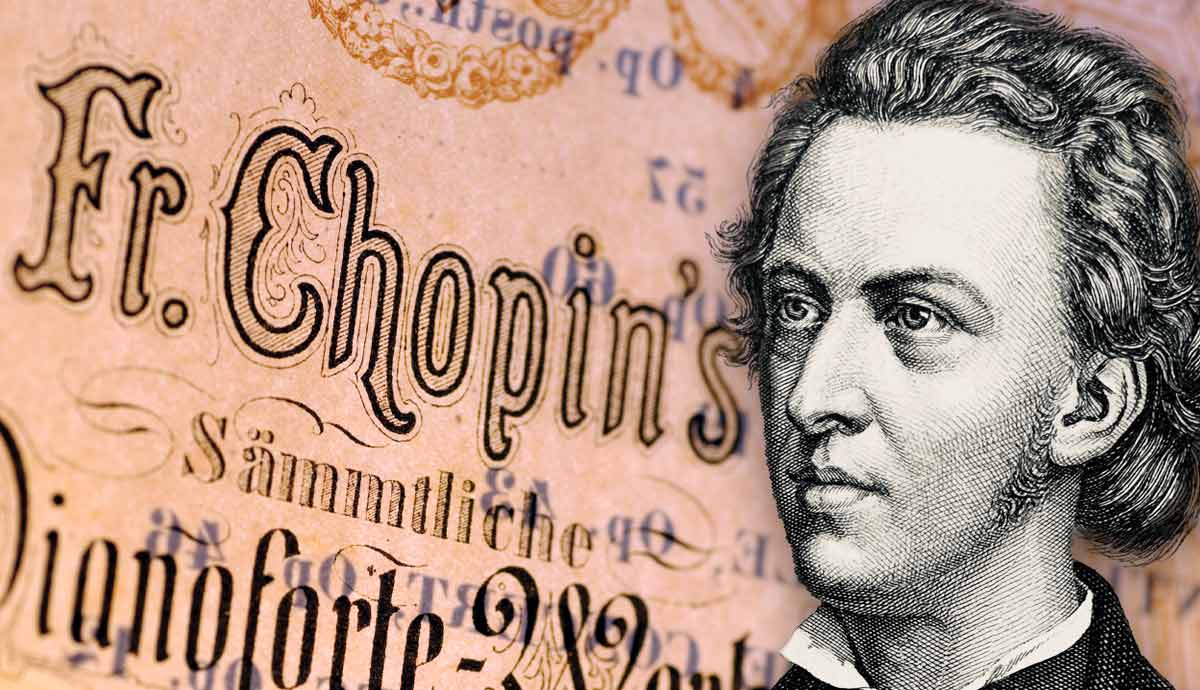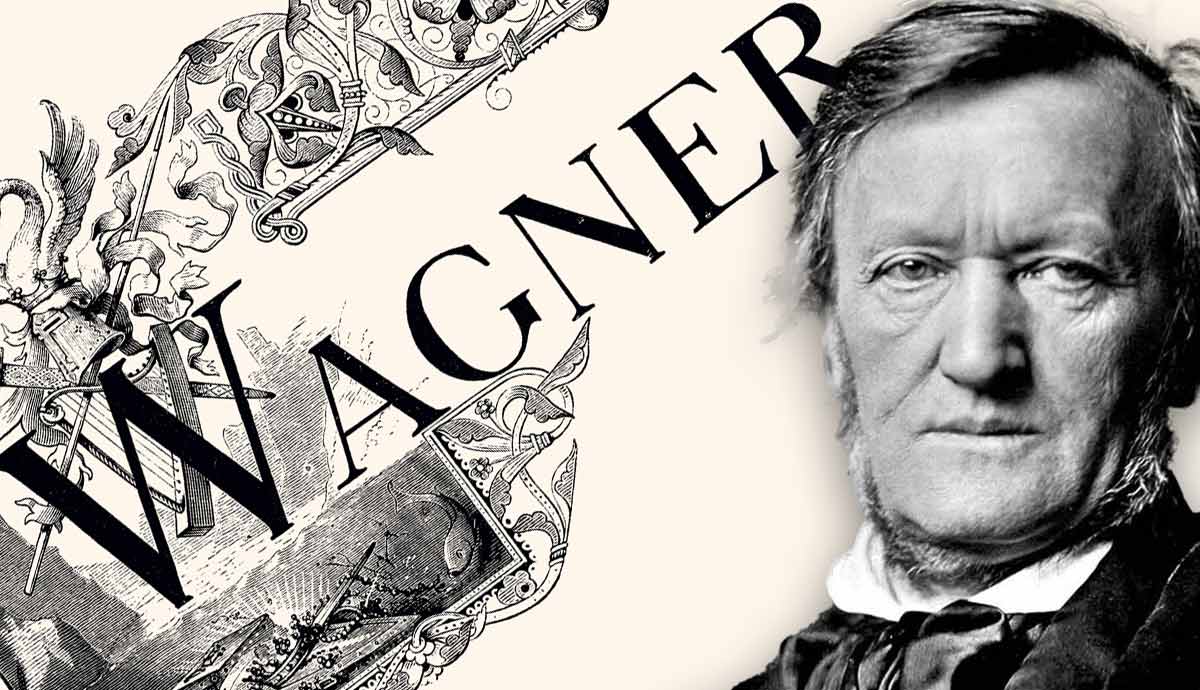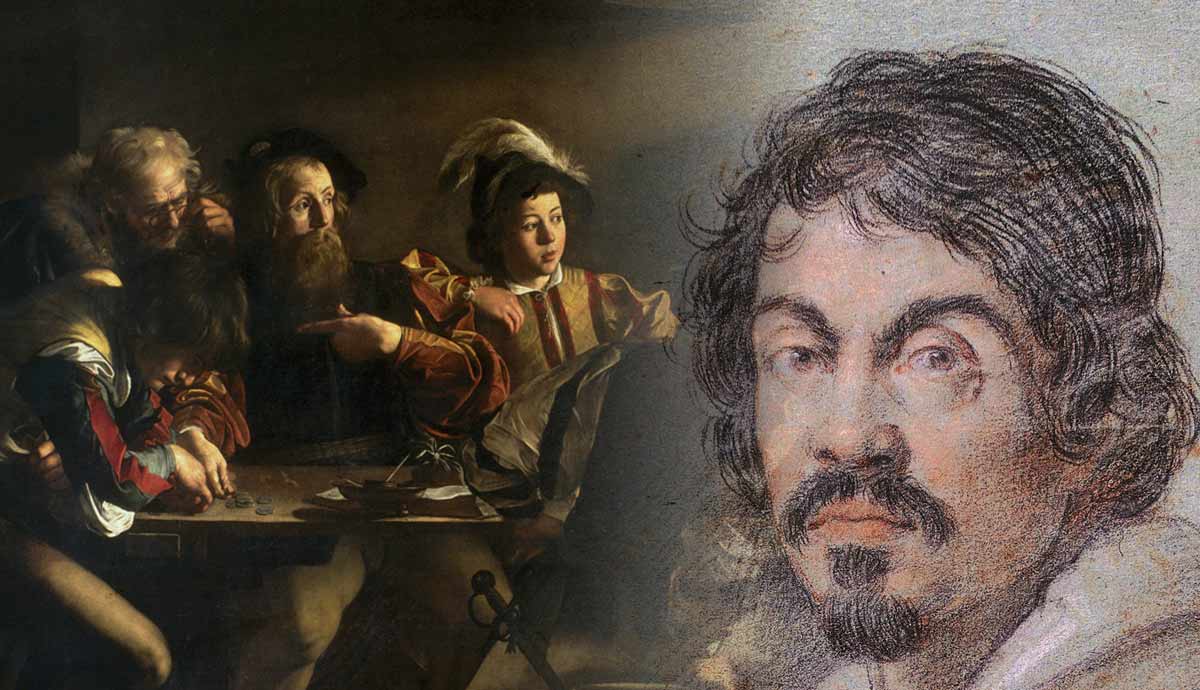
Frederic Chopin (1810-1849) was a renowned Romantic composer born in Poland. He is celebrated for his intricate piano music filled with emotional and musical richness.
Characteristics of Chopin’s Compositional Style?

Chopin’s piano music is characterized by five characteristics that help us understand his genius. At the center are his highly emotional, expressive melodies, rich in ornamentation, wide interval leaps, and an underlying sense of yearning.
He was also a master of form who freely bent the rules. Many works reshape traditional structures into something personal, often using cyclical form, where a theme returns in different guises. His harmony is equally distinctive and complex, full of chromaticism, dissonances, and bold chord substitutions. Unresolved tensions create suspense and give his music a Gothic influence within the Romantic era.

In Chopin’s music, you often hear extreme dynamics, from whisper-soft pianissimo to thunderous fortissimo. Sudden changes in volume heighten the drama and give his piano writing a distinctly Gothic edge.
His pieces are also famously difficult, like a gymnasium for the fingers, hands, and wrists. They demand exceptional dexterity and control, and he pioneered intricate techniques that pushed players to their limits. Alongside Franz Liszt, he helped transform the etude from a simple exercise into a concert showpiece. With this background in mind, we can now look more closely at the man behind the music.
Chopin’s Reinvention of Romantic Era Genres

Chopin constantly challenged accepted ideas about musical genre. He redefined many traditional forms and even created new ones, all while keeping a strong internal logic in his works. Using familiar genres as a framework, he subverted their usual associations and forged an expressive language that still captivates listeners.
Early on, he wrote within inherited forms like concertos, polonaises, and theme-and-variation pieces. As his voice matured, he stretched and recast these traditions, helping crystallize the modern shapes of etudes, impromptus, mazurkas, and nocturnes, and reshaping the meaning of mazurkas, polonaises, and preludes. He also pioneered new genres such as the piano ballade and the concert impromptu.
For Chopin, genre labels were never arbitrary: each carried clear associations he could both honor and cleverly unsettle. His nocturnes, for example, keep the intimate night-piece character while using unconventional harmonies to lead listeners into unexpectedly deep emotional territory.
Within his clear genre framework, Chopin made room for hybrid forms, blending elements from different genres to challenge expectations. For example, the Polonaise-Fantasy in A-flat major, Op. 61, fuses the improvisatory freedom of a fantasia with the rhythmic drive and majesty of a polonaise.
Though he departed from many Romantic conventions, he also redefined them, showing remarkable compositional mastery. His innovative techniques, combined with deep expressiveness and respect for musical tradition, helped secure his place as one of the greatest Romantic composers.
Understanding Frederic Chopin in 5 Compositions

Below are five compositions that illustrate Chopin’s innovative approach to genres and his unique piano technique.
1. Nocturne in E-flat Major, Op. 9 No. 2
A nocturne is a composition with some consistent features across the genre such as an ornamented, tuneful melody over a left-hand accompaniment using broken or flat chords. Perhaps the most notable feature is how it mirrors the operatic da capo aria: a contrasting and dramatic middle section is sandwiched between two calmer, more lyrical outer sections. The balance between calmness and agitation is key.
While this nocturne is not one of Chopin’s most beautiful nocturnes when compared to the others, it is perhaps the most popular. Young, bright-eyed pianists (my younger self included) cannot resist the temptation to learn this piece. The subtle accompaniment in the left-hand part resembles that of a melancholic waltz while the right-hand part carries the melody and floats above it. When you compare this piece to John Field, the inventor of the nocturne, some resemblances are notable — the choice of key signature and rhythmic structure stand out. However, unlike Field’s Nocturne No. 1 in E Flat Major, H.24, it does not contain Chopin’s melancholy strain or the dramatic “outbursts” found in some of the nocturnes.
2. Piano Sonata No. 2 in B-flat Minor, Op. 35
Chopin composed four piano sonatas during his lifetime, each featuring a unique approach. The Sonata in B flat minor, Op. 35, stands out because of its dramatic nature and it is considered one of the composer’s great masterpieces. His mastery of emotional expression, form, and harmony all contribute to the piece’s uniqueness. The Funeral March is one of the most recognizable pieces from the classical repertoire and was used during President John F Kennedy’s funeral procession in 1963.
The first movement marked Grave — Doppio Movimento (Slow — Double the Tempo) not only opens the sonata but ultimately points to the Funeral March. It is composed in a sonata-allegro form with two themes. First, the agitated first theme (at 00:25) grabs the attention of the listener while the second theme (ca. 00:58), in D-flat major, brings some introspective and melodic respite from the agitation. The middle section offers a contrasting and balladic treatment of the opening material. It almost feels surreal. During the recapitulation, the opening theme returns to haunt the listener as the movement ends unresolved.
In the second movement, the contrast and drama continue. The forceful Scherzo-section (at 07:56-09:05 and 12:41-14:26) embraces the calm and contrasting Trio (09:07-12:40). During the Trio section a slower tempo is used with a simple yet memorable melody.

The famous third movement follows with its moments of lament and rage against the inevitable march of fate. The Funeral March (14:34-22:52) was composed two years before the rest of the sonata. It was written on November 28, 1837 — the eve of the anniversary of the November Uprising (1830-31) in Poland. This suggests a patriotic element in the overall sonata, with the inevitable march of fate playing its part in Poland under Russian forces.
There is also an element of Chopin’s jittery imagination as described by George Sand in her memoirs. Chopin’s letter to Solange Clésinger (George Sand’s daughter) confirms it, too:
“When I was playing my Sonata in B flat minor amidst a circle of English friends, an unusual experience befell me. I executed the allegro and scherzo more or less correctly [Chopin was always self-critical] and was just about to start the [funeral] march, when suddenly I saw emerging from the half-opened case of the piano the cursed apparitions that had appeared to me one evening in the Chartreuse [on Majorca]. I had to go out for a moment to collect myself, after which, without a word, I played on.”
Or, maybe it was just a Romantic Era composer giving himself over to a brief flight of fantasy.
Finally, the last movement (at 22:56) closes the sonata. The continuous flow of musical material has been a topic of discussion since it was first heard. It can be best described as an epilogue to the sonata like a “wind blowing through a graveyard” in the aftermath of a war. However, one should exercise caution to ascribe extra-musical meanings to works like these. We run the risk of reducing the power of the work to a descriptive narrative that fits our prejudices instead of letting the music speak for itself.
3. Etudes Op. 10 and Op. 25
The piano etude, or didactic piece, before Chopin fulfilled one primary role: to develop pianistic technique. Examples that stand out are Gradus ad Parnassum (The Steps to Parnassus) by Muzio Clementi (1817), 84 Etüden by Johann Baptist Cramer, various books by Carl Czerny, and The Virtuoso Pianist by Charles-Louis Hanon, which have all struck fear into the hearts of pianists.
Chopin was inspired by the virtuosity of the violinist Nicolo Paganini and transformed the humble piano exercise into a higher form of art. He integrated technical proficiency with expressive music. Pianists could show off their proficiency — a revolutionary act on the part of a composer.

The twelfth étude in the Opus 10 collection is nicknamed the Revolutionary Étude or Étude on the Bombardment of Warsaw and is a study for the left hand. Popular legend states that Chopin composed this étude after the Battle of Warsaw that took place during the November Uprising in 1831. However, this claim cannot be corroborated, but it could be semi-autobiographical given the nickname (although he did not assign any nicknames to any of the études).
This étude’s difficulty lies in the relentless runs, scales, and arpeggios in the left hand. The right-hand part features wide octave passages that must be played smoothly to bring out the melody.
4. Preludes, Op.28
In Western music theory, there are 24 musical keys. Twelve of them are major (sounding happy and bright) and twelve are minor keys (sounding sad and dark). JS Bach was the first composer to establish this division and laid down this fundamental division in his work Das Wohltemperierte Klavier (The Well-Tempered Clavier, BWV 846-869).
While Chopin was working on his own set of preludes he was obsessed with Bach’s Well-Tempered Clavier — preliminary work was done during the years 1831 and 1837. He completed and refined the cycle on Mallorca in 1838.
The cycle of 24 preludes offers musical snapshots of musical expressions in a wide range of tone colors, emotions, dynamics, and rhythms. Chopin scholars group them into eight categories:
- Idyllic: Nos. 1, 7. 11, and 23
- Elegiac: Nos.2, 4, and 6
- Etude or etude-like: Nos. 3, 5, and 19
- Cantabile or Singable: Nos. 17 and 21
- Scherzo-like: Nos. 8, 10, and 14
- March- or Hymn-like: Nos. 9 and 20
- Ballade-like: Nos. 12, 16, 18, and 22
- Nocturne-like: Nos. 13 and 15
Considering that preludes usually preceded a larger work, or a fugue in the case of JS Bach’s Well-Tempered Clavier, Chopin’s preludes elevated the form. His preludes may be rooted in tradition, but they also offer a snapshot of his genius talent and the techniques he perfected and invented in less than 45 minutes.
5. Polonaise in A-Flat Major, Op. 53
This polonaise is a chimera: it has the polonaise’s majesty and pulse but is closer to a ballade with its dramatic and majestic nature.
A dramatic chromatic upward surge opens the polonaise (at 00:05) leading to the main polonaise theme at 00:33. The dramatic upward surge is how this polonaise earned its nickname as the “Heroic Polonaise.”
The trio section is introduced by six arpeggio chords (at 03:18) before the left-hand part introduces the soft, relentless octaves (at 03:24). At first the fanfare sounds far-off while the octaves provide a steady bassline. When the fanfare is repeated a second time (between 04:02 and 04:43) it sounds much “closer” and louder. With all the excitement found in the Trio section, the music turns to a reflective mood with a hint of melancholy floating underneath the surface (at 04:44).
After the calmness, the main polonaise theme triumphantly returns (06:05). A final upward surge introduces the coda (at 06:39), and is made up of material derived from the main theme.
Overall, this polonaise is marked by its technical difficulties, to name a few: playing trills with the weaker fingers, wide leaps between notes that require a legato approach, and rapid passages filled with octave scales.
Frederic Chopin: Final Thoughts

The 24 Préludes capture the spirit of the Romantic Era and Chopin’s compositional style while his Polonaises showcase Poland’s national dance and the composer’s love for his home country. While critics at the time did not know what to make of his Piano Sonata No. 2, it still stands as a monument to Chopin’s genius and how he adapted existing forms and genres to suit his compositional ideals. Today, the Funeral March from this sonata is instantly recognizable with over 500 different transcriptions available for almost any imaginable instrument. It is as haunting today as the first time audiences heard it almost 200 years ago. His Nocturnes are another example of how he adapted a genre to suit his needs while creating some of the most beautiful music ever written for the piano. Other composers composed etudes to teach pianists technical aspects of learning the piano, Chopin (along with Franz Liszt) elevated it to staples of the concert repertoire that still capture the admiration of audiences today.
Chopin, for me, is more than a Romantic composer — he is evergreen and his genius is matchless. His music is not likely to go out of fashion soon because he captures the spectrum of human emotions one work at a time.











